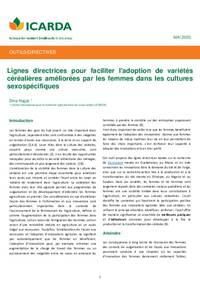Lignes directrices pour faciliter l'adoption de variétés céréalières améliorées par les femmes dans les cultures sexospécifiques

Authors:
Women in the Global South play significant roles in farming but face inequalities in access to resources, land and extension support (3,4,5). Their roles in farming cereals, often perceived as male crops, are especially undermined (2). The results are missed opportunities to achieve increased food security in households, communities and nations more broadly (7,8). Improving the visibility of women in cereal farming is an essential first step to improve their access to inputs and close the gender yield gap in farming. Validating women in their farming roles enables extension and development programs to reach women farmers in the first place. These considerations for improving women’s access to information and innovations are especially important in context of increased feminization of agriculture, defined here as increased participation for women in agriculture due to either male-outmigration or reduced profitability in farming yet with unequal access to resources. However, improved access to resources and adoption of agricultural innovations does not automatically mean that women benefit. Adoption of innovations can, for example, lead to increasing women’s workloads or widening gender inequalities by leading to men taking control over an enterprise previously controlled by women (9). As such, it is important to ensure that women also benefit from the adoption of innovations. Empowering women to take increased control over their lives by enabling them to important choices stands to strengthen their abilities to adopt innovations and benefit from these innovations.
